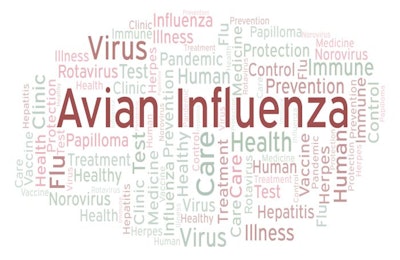
Three new outbreaks of highly pathogenic avian influenza (HPAI) in South Korea have pushed to country’s total to the milestone of 100.
According to Yonhap, the latest cases were detected on two poultry farms and in one small mixed poultry flock. Numbers of birds involved are not reported, but the premises are in different provinces. Affected are a duck farm in Goesan county in the central province of North Chungcheong province, and one with egg laying hens in the northwest in Hwaseong (Gyeonggi province). The small flock is in the far south of the country, in Tongyeong county, which is in South Gyeongsang province.
A further outbreak is suspected in the Gyeonggi province city region of Icheon, according to the latest report from the same source. Presence of an H5 virus has been confirmed there, but its pathogenicity is still under investigation.
For the first two of these outbreaks, all poultry will be culled within 3 kilometers of each infected premises. However, following subsequent outbreaks and for a limited period, the latest culling order will apply only to poultry within one kilometer of an outbreak, and to poultry of the same type, reports Yonhap.
After two weeks of operating under eased culling rules, the ministry of agriculture will consider whether to continue with the amended policy.
Since the first HPAI outbreak of this winter in November of 2020, 28.6 million poultry have been preventatively culled in South Korea to halt the spread of the disease.
One result has been a sharp rise in egg prices. Yonhap reports these are currently almost 50% higher year-on-year, despite a recent government move to lift import tariffs on eggs. However, chicken meat prices have fallen over recent weeks, and the average is now only 7% above last year’s level.
Number of South Korean wild birds testing positive for the HPAI virus is now approaching 200, according to the same source.
In Japan, there have been no new reports of HPAI cases in local media. Data from the Japanese agriculture ministry indicates no recent additions to the 50 primary outbreaks registered last week.
India: No cases but market disrupted
According to official reports, presence of the H5N1 and H5N8 HPAI virus variants have been detected in several Indian states since the start of this year. Infections have resulted in preventative culling of poultry, restrictions on the movements of birds and products, as well as mass mortalities of wild birds.
Since the first cases were confirmed in Maharashtra on January 8, 712,000 poultry have been culled in this western state, reports Indian Express. Furthermore, 2.6 million eggs and 73 metric tons of feed have been destroyed.
As well as these losses, local poultry farmers have been hit by very low prices for their products. In December, the price average 81 rupees (INR; US$1.12) per kilo for a market-ready bird of around 2.5kg. This had fallen to INR60 by January and is now around INR56. Initial fears of human infections caused consumers to avoid buying chicken. While consumption is now recovering, many farmers sold their birds early to avoid the risk of the disease impacting their flocks. This led to a glut of chicken on the market, and prevented a price recovery.
According to the same source, the market situation is similar in the city of Pune.
In the northern state of Punjab, no new cases of avian flu have been confirmed recently, reports Times of India.
In the district of Mohali, three farms in the village of Behera were hit by HPAI around three weeks ago. Since then, 84,500 poultry at the premises have been culled, 2,760 eggs and 129 metric tons of feed destroyed, and the areas has been disinfected. Subsequent tests of poultry, birds, and people in the area have revealed no further infections.
In the past week, wild birds found dead in two northern Indian states have tested positive for avian flu.
The H5N1 virus variant has been detected in a wetland area visited by migratory birds in the Panchkula district of Haryana state, reports The Tribune.
In Kashmir in the far north of India, a recent mass mortality of crows has been attributed to HPAI, according to Greater Kashmir.
Both sources report that a one-kilometer infected zone and 10-kilometer alert zone have been set up around the outbreaks. Backyard flocks are being checked for the virus. No movements of birds or poultry products are permitted within the infected zone, or between the two zones. Only disease-free birds and products can be brought into the area.
Avian flu 'under control' in Senegal
No new cases of HPAI have been detected in the Republic of Senegal, according to Senegalese Press Agency APS.
A poultry farm in western region of Thiès has been depopulated of poultry, cleaned and disinfected, according to the regional livestock service. So far, no samples taken from these premises have tested positive for the avian flu virus.
At the end of December, the H5N1 variant of HPAI virus was found at a poultry farm near the town of Pout in Thiès region. This was the first HPAI outbreak to have occurred in this West African country. Almost 60% of the around 100,000 laying hens at the commercial egg farm died in the initial wave of the disease.
APS reports that the surviving birds were culled and destroyed by January 10. All carcasses have been buried.
For the time being, at least, the outbreak is under control, according to the head of the livestock service. Surveillance of farms in the area is set to continue.
Earlier this year, the same virus variant was detected following the mass mortality of pelicans in Senegal and neighboring Mauritania.
In recent days, the first ever transmission of the H5N8 virus from poultry to people has been reported. Nevertheless, consumers are being assured that poultry meat remains safe to eat.
View our continuing coverage of the global avian influenza situation.

















